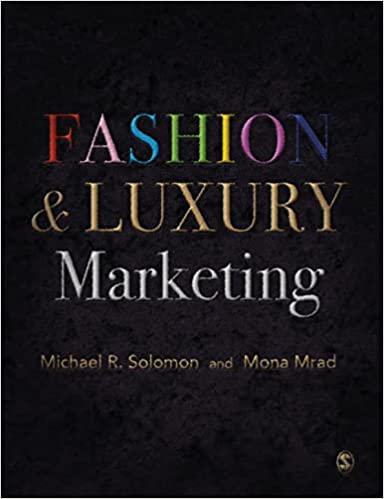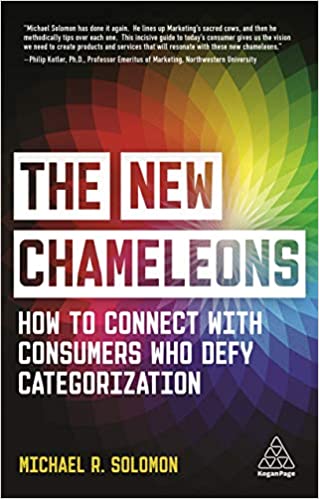Michael Solomon Speaker Biography
Marketing Expert and Best-Selling Author of
Consumer Behavior: Buying, Having and Being
Michael Solomon partners with marketers and leaders to help them understand the minds of today’s consumers in our volatile economy. Nothing keeps business leaders up at night more than knowing how quickly their brand can be negatively impacted.
Consumer Behavior
Regardless of the size of a company, fully understanding consumer behavior is paramount to not only surviving in today’s market, but also thriving. This is exactly why Michael is THE go-to expert when it comes to knowing the psychology of the buyer, he’s been studying consumer behavior for decades, across all generations. He understands that today’s buyer is NOT your cookie cutter consumer. His book Marketing Expert and Best-Selling Author of Consumer Behavior: Buying, Having and Being is the most widely used book on the subject in the world.
New Chameleons
Michael’s presentations provide a visual excursion into the minds of consumers and what influences them to buy. His latest book, The New Chameleons: How to Connect with Consumers Who Defy Categorization, recently won the NYC Big Book Award for the Marketing & Sales/PR category. The book stitches the trends of today to the future of consumerism in a way that is both provocative and inspiring.
Accolades
The marketing guru Philip Kotler summed it up when he stated, “Solomon has the mind of a scientist and the writing flair of a journalist.
Clients
Michael advises global clients in leading industries such as apparel and footwear (Calvin Klein, Levi Strauss, Under Armour, Timberland), financial services and e-commerce (eBay, Progressive), CPG (Procter & Gamble, Campbell’s), retailing (H&M), sports (Philadelphia Eagles), manufacturing (DuPont, PP&G) and transportation (BMW, United Airlines) on marketing strategies to make them more consumer-centric.
Media
He regularly appears on television shows including The Today Show, Good Morning America and CNN to comment on consumer issues, and he is frequently quoted in major media outlets such as The New York Times, USA Today, Adweek and Time.
Professor of Marketing
As a Professor of Marketing (in the Haub School of Business at Saint Joseph’s University in Philadelphia) and an industry consultant, Michael combines cutting edge academic theory with actionable real-world strategies. He helps managers get inside the heads of their customers so they can anticipate and satisfy their deepest and most pressing needs – today and tomorrow. An executive at Subaru said it best: “The man is a scholar who is current and street-wise.”
Michael Solomon Speaking Topics
Consumer Behavior in The New Normal. Step on the G.A.S. (Gratification, Agency & Stability)
The Pandemic has changed our world and will continue to do so for years after the virus disappears. We’ve had to rethink and modify our purchase decisions, large and small. Some disruptions in consumer/marketer relationships that already were looming come faster and more decisively. How do we define brand value? How should companies talk to customers? How do people function in an emerging gig economy where every encounter might be fatal? How do we redefine what it means to go to work or to socialize? The virus poked the bear, and now marketers need to respond to life in The New Normal. The changes that started before 2020 reflect the transition in our society from a modernist to a postmodern culture. Postmodern consumers don’t always follow the rules that marketers decree. That’s because we don’t buy products because of what they do… we buy them because of what they mean. Today’s consumers define themselves by the brands they choose. Their idiosyncratic choices create a pastiche of meaning that gets updated 24/7. Marketers no longer drive the train, even though they can still ride it. This means that the firm categories we love to use to understand our world – and our customers – are no longer valid. In particular, the traditional labels we use to segment consumers have stopped working. Today’s consumers are like chameleons, who change color constantly. They no longer sit passively in the tidy cages we put them in. The convenient dichotomies we rely upon, such as Male vs. Female, Young vs. Old, I vs. We, Consumer vs. Producer, Offline vs. Online, and many others, no longer mean very much. In the New Normal, we’ll see these cages open even faster as people are exposed both to new possibilities and to new constraints on their daily lives. Many of us for example will rediscover the value of community, and others will rethink the value of commuting to work every day. In this presentation, we’ll explore some of these comfortable cages, and show why marketers need to ignore them in order to prosper.
Profit from Disruption. Tear Down Marketing’s Old Walls to See the Future of Your Business
Fundamental categories that form the bedrock of marketing strategy and customer insights simply no longer exist. You need to understand the new landscape of consumer behavior, so you don’t get left in the dust.
The Many Faces of Artificial Intelligence. Persuasive Salesbots and Tomorrow’s Customer Experience. The Face of AI THEN versus The Face of AI NOW
Everyone is buzzing about Artificial Intelligence these days, as well as they should. Machines that “think” for us already are transforming how we work, play – and shop. McKinsey tells us that some 29 million U.S. homes used some form of smart technology last year, and that number grows by over 30 percent a year. Many organizations now deploy robots, avatars and chatbots to perform tasks we used to ask flesh-and-blood people to do. This suddenly makes the age-old question of what makes us human much less theoretical. Self-driving cars threaten to replace truck drivers. IBM’s Watson beats chess masters and veteran Jeopardy game show contestants. Movies and TV shows like Blade Runner, Westworld, and Humans that focus on the civil rights of synths, replicants and androids are center stage in popular culture. Alexa and Siri are our new guardian angels. Where does the person stop and the machine start? Marketers need to grapple with this question, and soon. As customers increasingly interact with machines instead of people, there are huge ramifications for the way we think about sales interactions, communications strategies, product design and marketing channels. Will consumers more readily accept a product recommendation from an AI agent if an attractive avatar delivers the message? Will customers become loyal to an intelligent agent, much as some do with their favorite salespeople now? Will shoppers prefer to see computer-generated models in advertising rather than real people?
Be the First Choice!
Everything is a choice. From making someone a leader of an organization or team to deciding which company to work for. Preparing for change management in an organization or buying one brand over another or even responding on a dating site, a choice is a problem to be solved. Some economists tell us that we are like robots – calm, cool, collected decision-making machines that carefully weigh all the evidence and make the best objective choice. The real world doesn’t work that way! Our choices and other behaviors often seem “irrational” after the fact, but there’s often a method to our madness — even if we don’t know what it is. So, what drives our choices? To answer that question, we need to understand the hidden forces that bias our decisions. Don’t be #2! I can help you to identify the hidden triggers that drive our choices. BE THE FIRST CHOICE.
Walk a Mile in Your Customer’s Shoes
The customer is king (or queen). Yet the best product or service will fail if consumers don’t have a positive encounter when they consume it. That’s because what you sell is NOT a product – it’s an experience that consists of the core offering plus everything that goes with it. This includes the physical or digital environment where shoppers find it, the people who sell it, and even how others react to the purchase. This experience is what attracts – or repels – the customer. With so many options available, he or she will quickly walk away from a negative encounter. But he or she also will reward organizations that provide satisfying experiences with long-term loyalty. At the end of the day, it’s vital for marketers to become more consumer-centric – to understand the experience from the customer’s perspective rather than just the manager’s perspective. And, that challenge is even more daunting when we understand that today’s consumer is changing dramatically as he or she finds new ways to interact with companies. This fundamental insight is what is drives increased interest in customer experience management (CEM or CXM). A growing number of organizations now recognize the importance of tracking every interaction with customers as if it is their last – because it could be. You’ll get a through overview of today’s consumer, and the major issues we need to understand in order to create and maintain a positive customer experience over the long-term.
We Really ARE What We Wear: How the Psychology of Fashion Influences Consumer Behavior
“We buy products because of what they mean, not because of what they do.” That insight is crucial for any industry that touches consumers. Customers literally choose from thousands of options – and most of them have very little to do with functionality. However, that doesn’t make these decisions unimportant by any means. The selection of a watch, a bracelet, a pair of glasses or many other items reflects deep-seated values and beliefs about appearance and the consumer’s identity. We can think of the body as a canvas, where the shopper chooses from a “palette” of accessory items, apparel, footwear, cosmetics and other products to paint a picture s/he wants the world to see at a fixed moment in time. Marketers need to dig deeper if they want to sync their offerings with what their customers seek. In this presentation, we’ll look at some of the powerful cultural forces that influence how consumers use a range of products to make “statements” about themselves. We’ll examine some of the important factors that influence what that “self-portrait” looks like, including feelings about the body, peer pressure, celebrity endorsements and the messages our culture sends about what men and women need to look like. We’ll also consider how new technologies such as social media communities, wearable computing and augmented reality will color this picture in the near future.
Michael Solomon Books

Fashion & Luxury Marketing
Purchase Book
The New Chameleons: How to Connect with Consumers Who Defy Categorization
Purchase BookMichael Solomon Videos
Michael Solomon Articles
Michael Solomon Speaker Testimonials
Michael was phenomenal at MARsum USA 2021! With rapidly evolving consumer behavior and demands after COVID-19, choosing Michael as our opening keynote speaker was a natural, obvious choice owing to his expert authority on this subject and of course, his treasury of effective brand-building strategies. Flawlessly eloquent, he completely reigned over the stage with his natural, engaging style and kept the audience hooked throughout his two keynotes which focused on building & sustaining fashion brands and the untapped potential of AI-powered salesbots. His content was loaded with actionable insights, well-researched stats, market predictions, AND he also managed to make us learn, think, and laugh at the same time! Getting him back for our next edition would be a no-brainer.
- | Prizm Events
Michael was a great speaker who shared his expertise in an engaging and thoughtful manner. He set the tone for collaborative conversation with other speakers and was wonderful to work with!
- Director of Enterprise Marketing | True Fit Corporation
Michael Solomon delivered a timely and thought-provoking talk on how we should all be thinking about the consumer in the new semi-normal, giving us a view that brought together his real-world experience through his consulting with numerous multi-national companies/brands that are all trying to navigate through the pandemic. He took a lot of disparate information and packaged it into digestible, understandable components and then told us how to apply the lessons learned to our businesses. He not only identifies the issue, but also delivers on the solution. We look forward to hearing from Michael again as the situation we all find ourselves in evolves.
- President | Home Fashion Products Association





